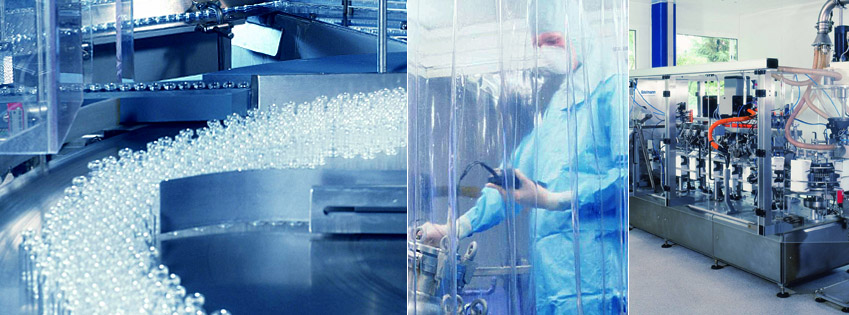
The quality of a product is determined through the manufacture. For this reason, production processes take place according to clearly-defined and qualified or validated procedures, which accord with the basic principles of Good Manufacturing Practise. Measures are taken for the prevention of cross-contaminations and confusions and for the maintenance of the microbiological requirements. The status of each stored product is made unambiguously clear, so that the same level of safety is secured as if they were stored in separate rooms. Raw materials and new products are kept in quarantine until Quality Control releases the batch(es). The ambient conditions in the different storage areas are regularly monitored and corrected if necessary.
Application technology:
Due to the manufacture of different galenic forms, deviating application technologies result, which however display concordances in their basic requirements. The aim here is the production of a homogeneous bulk preparation which is achieved with the aid of a batch tank in the Liquids Division or using a powder mixer in the Solids Division. These standard procedures have been described in sufficient detail in the pertinent Standard Working Instructions or Process Instructions, and the procedures themselves have been qualified or validated.
Other necessary framework conditions for the individual galenic forms, such as:
- The extraction of dusts
- Class A areas for products to be treated as aseptic
- Mixing or agitator plants
- Cleaning/sterilisation measures on bulk goods or on equipment
- Germ reduction or sterile filtration
are ensured through the spatial and plant technologies and/or the supply of mediums. The regular inspection of these operating parameters is ensured through the existing monitoring regime, the preventative maintenance and the calibration of objects for which calibration is mandatory.
Filling:
The filling and sealing of oral/non-sterile and sterile products takes place in accordance with the specifications laid down in the appropriate directives. Here, too, product protection has maximum priority. The necessary framework conditions are ensured through the spatial and plant technology and/or the supply of mediums; the regular inspection of these operating parameters is ensured through the existing monitoring regime, the preventative maintenance and the calibration of objects for which calibration is mandatory.
Sterilisation:
A number of parenteral products - primarily infusion solutions - are accessible for terminal sterilisation in the final container. The autoclaving process follows the requirements of the pertinent chapters in pharmacopoeias, and fulfils the physical requirements. The autoclaving cycles used are qualified. The verification of the correct final treatment is produced specific to each batch and forms part of the manufacturing documentation.
Packaging:
All packaging processes are documented in accordance with approved product and packaging size-specific packaging instructions, and recorded in the manufacturing/packaging protocol.
In-process inspections:
In-process inspections serve the monitoring and control of a running process. Major parameters such as:
- The introduction of raw materials into a batch tank or mixer,
- The appearance or the pH value of solutions,
- Filling quantities acc. Finished Packaging Ordinance or
- The completeness and external integrity of packaging
take place specific to each batch. They are carried out by Production personnel and the results are recorded in the manufacturing protocol.
Production hygiene:
The aim of production hygiene is to avoid microbiological contamination of products. For this reason, diverse regulations have been made:
Bacterial count limits exist for all finished pharmaceuticals. Raw materials are inspected according to their source (chemical, herbal etc.) and their area of application (solid dosage form, parenteralia etc.) by Quality Control as to their microbiological status. Particular emphasis is laid on biological preparations. Aqua purificata and water for injection purposes are inspected daily. Production rooms are cleaned and disinfected acc. the pertinent SAAs. In order to achieve a bacterial count reduction in the ambient air, controlled ventilation via filters is employed. The bacterial count in the air is regularly inspected and documented. Personnel are trained with regard to hygienic conduct and protective clothing. The equipment is designed for easy cleaning. Cleaning takes place according to validated cleaning procedures. No residual rinsing water may remain. Depending on the area of application, additional disinfection or sterilisation takes place. Manufacturing processes are carried out in enclosed systems where possible. Raw materials, intermediate products and bulk goods are transported in sealed containers.
Measures for the prevention of cross-contamination:
When different preparations are manufactured in one room, suitable measures must be taken to ensure that the risk of cross-contamination is minimised, for example by using partitions or through campaign production. Extractors are required for processes which generate a lot of dust. The material flow is organised so that no unnecessary routes have to be taken. Enclosed systems and line production are targeted.
Responsibilities:
The Head of Production is responsible for implementation of the points concerned here. The detailed delimitation of the responsibilities, in particular against those of the Head of Control, is defined in the respective job descriptions.